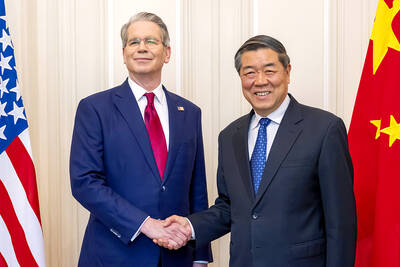VIA Technologies Inc (
VIA, Transmeta Corp and Advanced Micro Devices (AMD) Inc are Intel's only competitors, but together accounted for less than 20 percent of the global market for computer chips last year, the report said.
"It is widely recognized that Intel makes a very formidable competitor, and conventional wisdom would dictate that it is fool-hardy of these companies to challenge the behemoth's grasp on this market," said Kevin Krewell of In-Stat/MDR. "But like moths to the flame, each is drawn by the promise of riches selling [computer] processors."
VIA needs to break free from copying Intel's infrastructure to compete, the report said.
"Just as AMD did with Athlon, VIA must create an infrastructure independent of Intel's. VIA is in a good position to do so because of its extensive system logic experience," the report said.
Gaynor de Wit of VIA's international marketing department welcomed the report.
"As part of our settlement with Intel we have to go ahead and start doing this [creating an independent infrastructure]," she said.
In April, VIA and Intel settled patent disputes that they had launched against the other in September 2001.
De Wit claims VIA is in a good position to achieve that goal.
"We have technology relating to all areas of the computer platform, such as networking, communications, graphics, multimedia and so on. We can fine-tune around this," she said, without elaborating on how VIA would create the new infrastructure.
But analysts were skeptical and advised VIA to stick to its current strategy of exploiting new markets.
"It will be very difficult for VIA to [create a new infrastructure," said Steven Liao (
"VIA's original intention was to move into the central processing unit market, but it couldn't compete with Intel, so it refocused its efforts on entry-level PCs. It has also focused on China, which is a new market. I think this is probably the only feasible way for VIA to go," Liao said.
Last year VIA introduced a new line of low-cost energy-
efficient chips that can be combined to create computer systems that perform the functions required by the average user, like playing DVD movies and connecting to the Internet.
"We offer low-power processors that do the job, but don't aim to match the gaming or high-power of Intel's processors," de Wit said.
VIA may not be able to match Intel's products as it does not have the resources.
"I don't believe they can beat Intel in computer chips," said Benny Lo (
VIA spends around NT$600 million per quarter on its research centers in California and Texas, Lo said.
De Wit confirmed that 75 percent of the company's 2,500 employees worldwide are engineers. That contrasts with Intel which spent US$4 billion on research last year, according to its Web site, and employs 6,000 researchers and scientists in laboratories around the world.

RECYCLE: Taiwan would aid manufacturers in refining rare earths from discarded appliances, which would fit the nation’s circular economy goals, minister Kung said Taiwan would work with the US and Japan on a proposed cooperation initiative in response to Beijing’s newly announced rare earth export curbs, Minister of Economic Affairs Kung Ming-hsin (龔明鑫) said yesterday. China last week announced new restrictions requiring companies to obtain export licenses if their products contain more than 0.1 percent of Chinese-origin rare earths by value. US Secretary of the Treasury Scott Bessent on Wednesday responded by saying that Beijing was “unreliable” in its rare earths exports, adding that the US would “neither be commanded, nor controlled” by China, several media outlets reported. Japanese Minister of Finance Katsunobu Kato yesterday also

Jensen Huang (黃仁勳), founder and CEO of US-based artificial intelligence chip designer Nvidia Corp and Taiwan Semiconductor Manufacturing Co (TSMC, 台積電) on Friday celebrated the first Nvidia Blackwell wafer produced on US soil. Huang visited TSMC’s advanced wafer fab in the US state of Arizona and joined the Taiwanese chipmaker’s executives to witness the efforts to “build the infrastructure that powers the world’s AI factories, right here in America,” Nvidia said in a statement. At the event, Huang joined Y.L. Wang (王英郎), vice president of operations at TSMC, in signing their names on the Blackwell wafer to

‘DRAMATIC AND POSITIVE’: AI growth would be better than it previously forecast and would stay robust even if the Chinese market became inaccessible for customers, it said Taiwan Semiconductor Manufacturing Co (TSMC, 台積電) yesterday raised its full-year revenue growth outlook after posting record profit for last quarter, despite growing market concern about an artificial intelligence (AI) bubble. The company said it expects revenue to expand about 35 percent year-on-year, driven mainly by faster-than-expected demand for leading-edge chips for AI applications. The world’s biggest contract chipmaker in July projected that revenue this year would expand about 30 percent in US dollar terms. The company also slightly hiked its capital expenditure for this year to US$40 billion to US$42 billion, compared with US$38 billion to US$42 billion it set previously. “AI demand actually

RARE EARTHS: The call between the US Treasury Secretary and his Chinese counterpart came as Washington sought to rally G7 partners in response to China’s export controls China and the US on Saturday agreed to conduct another round of trade negotiations in the coming week, as the world’s two biggest economies seek to avoid another damaging tit-for-tat tariff battle. Beijing last week announced sweeping controls on the critical rare earths industry, prompting US President Donald Trump to threaten 100 percent tariffs on imports from China in retaliation. Trump had also threatened to cancel his expected meeting with Chinese President Xi Jinping (習近平) in South Korea later this month on the sidelines of the APEC summit. In the latest indication of efforts to resolve their dispute, Chinese state media reported that